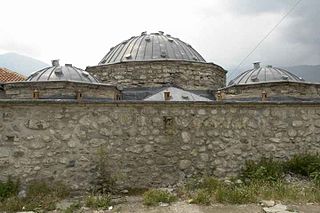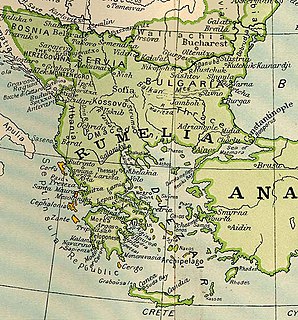 W
WThe Sanjak of Albania was a second-level administrative unit (sanjak) of the Ottoman Empire, located in what is today central and southern Albania. Its territory stretched between Krujë in the north and Kalamas river in the south. It was established in 1415–17, and was disestablished in 1466 with the establishment of the Sanjak of Elbasan.
 W
WDjebedji was a military subunit of Ottoman Army's artillery corps.
 W
WThe Great Hammam of Pristina is one of the few Ottoman era monuments in Pristina, Kosovo. Hamams are also known as Turkish baths. It was built in the 15th century and was part of the Imperial Mosque (Pristina). During the months of summer and spring, it was used as a meeting place. Considered to be one of the most important buildings of the cultural and historical heritage, the Great Hamam of Pristina was in poor condition through the years until its approval of restoration.
 W
WThe Halveti's tekke is a 350-year-old tariqah in the center of Prizren. The tekke object of the Halveti is found in the Saraçët neighborhood, near the Kukli Mehmed Bey's mosque. The Havlet Tariqah was established at the end of the 16th century, by father Osman who came to Prizren and lived in Kukli Mehmet-Bey's mosque. The object is simple, built of stone and mud while the coverage is made from traditional brick. The tekke complex consists of several buildings, such as the tekke, rites room (semihane), shrine, residential building and waiting room. More generally, the complex consists of two parts – the tekke and the rites room.
 W
WThe Imperial Arsenal was the main base and naval shipyard of the Ottoman Empire from the 16th century to the end of the Empire. It was located on the Golden Horn in the Ottoman capital, Constantinople.
 W
WKarli-Eli, also Karli-Ili or Karlo-Ili, was the Ottoman name for the region of Aetolia-Acarnania in western Greece, which formed a distinct administrative unit from the late 15th century until the Greek War of Independence.
 W
WThe Peja Hamam or Old Bath is an Ottoman-Turkish bath built in the second half of the 15th century. The building consists of an asymmetric "double" bath. According to some sources the bath was reconstructed in 1861 because of unknown reasons. The bath was damaged during war and was reconstructed after. Today, the hammam serves as an exhibition hall for different art shows and more.
 W
WRumelia, etymologically "Land of the Romans", was the name of a historical region in Southeastern Europe that was administered by the Ottoman Empire, corresponding to the Balkans. In its wider sense, it was used to refer to all Ottoman possessions and vassals that would later be geopolitically classified as "the Balkans".
 W
WŞahruh Bridge is a historical bridge in Turkey
 W
WThe Sanjak of Monastir or Manastir or Bitola, was a sanjak within the Rumelia Eyalet (1465–1867) and then the Manastir Vilayet (1874–1912). The administrative seat was in Manastir (Bitola).